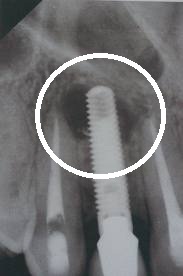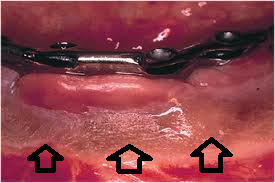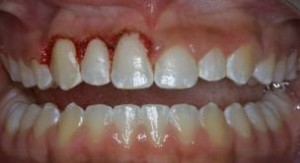One of the prime causes of dental implant failure is infection. However, in the United States at least, this is very uncommon. Dental implant manufacturers make great efforts to sterilize and package their dental implants so that there is no bacterial contamination. The mouth contains many potentially harmful bacteria that lurk in the gums tissues and any of these bacteria can possibly invade the area around an implant.
Dental implant infection occurs when there is bacterium in the implant region. This bacteria multiples, causes irritation, pus, and tissue trauma. Dental implant infection is the number one reason that an implant is rejected by the body and the procedure is deemed a failure. In most cases, the infection cannot be controlled via medication alone. Instead, the dentist will often need to go back into the mouth, remove the implant and do the procedure again after cleaning the infection out. This often means that additional dental work is needed for the implant to take and the mouth to remain healthy.
Infection occurs at the site where the implant fixture attaches to the bone. It can be characterized by redness in the surrounding tissue, soreness, looseness, or an unpleasant taste or smell coming from the site. The unpleasant taste and smell, on the other hand, are usually caused by bacteria in the mouth. If the unpleasant taste still lingers after you have brushed or flossed, the bacteria must be hiding in some areas where they can’t be reached by regular brushing and flossing. These bacteria are most likely to thrive in places where the implants are placed in. The unpleasant smell caused by the bacteria, better known as bad breath, can also be a sign of implant infection.
Redness of the surrounding tissue nearby the implant is another sign that you must be aware of. In any surgical operation like dental implant placement, nerves are prone to damage. This can have effect on the surrounding area of the implant by making it numb. As a result, pain may not be experienced during the early stages of infection. But the swelling part causing it red should be considered as a sign of implant infection. This requires your immediate attention.
Causes of dental implant infection
There are several possible causes to be aware of:
|
Treatment of dental implant infection
Many people have the idea that antibiotics alone can treat this. But without treating the cause of the infection, the use of antibiotics alone is often harmful, because they breed bacteria that are resistant to the antibiotic being used. The source of the infection needs to be eliminated.
So if the problem is a loose implant, or improperly fitting implant parts that are attracting bacteria, the offending fixtures need to be replaced. Once a fixture becomes mobile, removal is generally the only option for treatment.
Sometimes, proper dental implant maintenance is all that is required. They need to be cleaned regularly, just as teeth need to be cleaned.
Prevention of dental implant infections
The following instructions can help to prevent the development of a dental implant infection:
Pre-emptive prescription of antibiotics for some days prior to surgery can help reduce the risk of implant infection.
Sterile environment during the implant surgery is necessary for avoiding surgery infections.
After surgery, most implant dentists will prescribe antibiotics and recommend the use of an antibacterial mouthwash.
Patients must maintain proper daily oral hygiene (brushing and flossing) in combination with preventive visits to the dentist and periodic dental cleanings.
Smoking should be avoided because it delays healing and increases the risk of infections.
For patients of high risk groups, the implant dentist may recommend periodic x-rays to help diagnose and treat any problem of implant infection as soon as possible.


